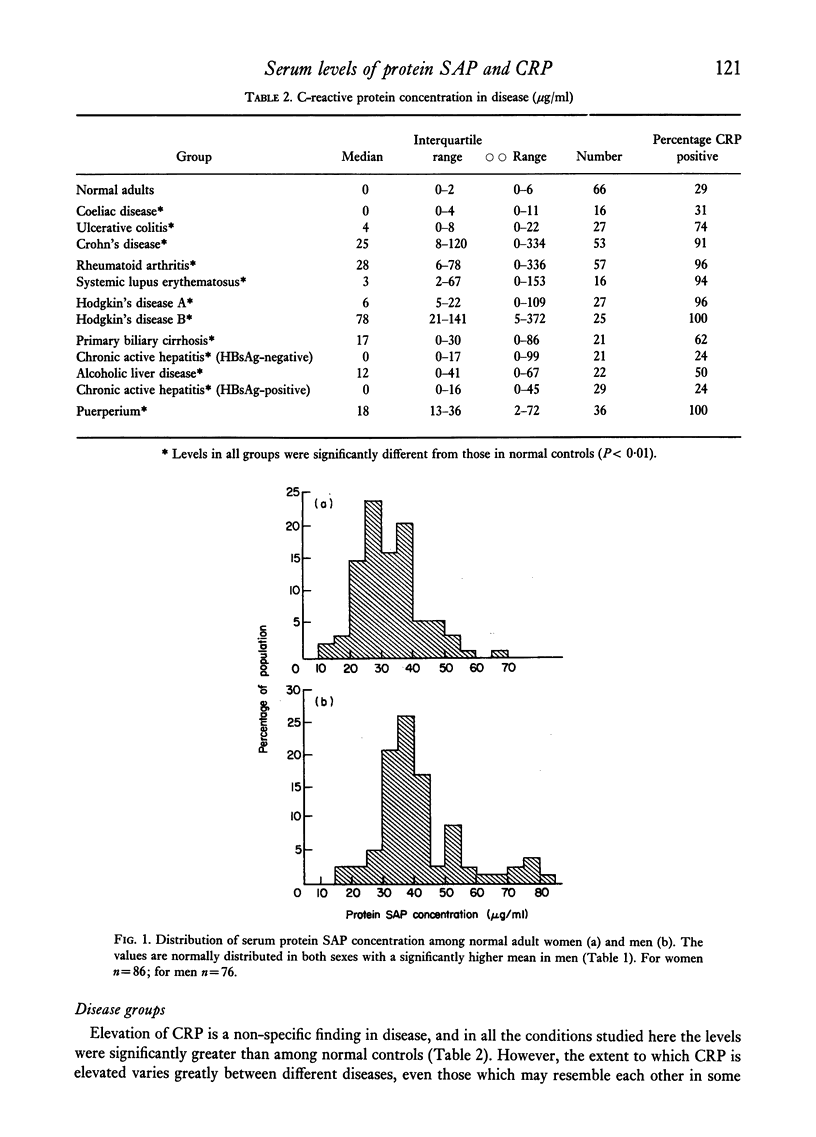Abstract
The serum concentration of protein SAP (amyloid P component) has been measured for the first time in a substantial series of normal individuals and patients with various diseases, and the results contrasted with the levels of the related protein C-reactive protein (CRP). The mean +/- s.d. concentration of protein SAP was 43 +/- 14 microgram/ml in seventy-six normal men, 33 +/- 10 microgram/ml in eighty-six normal women and 4 +/- 2 microgram/ml in thirty-six normal cord sera. Unlike CRP, whick is a major acute phase reactant, protein SAP was only slightly elevated in inflammatory and neoplastic diseases in which CRP was greatly increased. The level of protein SAP was significantly depressed in patients with hepatic disease, suggesting that its measurement might be of value in their management.
Full text
PDF





Selected References
These references are in PubMed. This may not be the complete list of references from this article.
- Amos R. S., Constable T. J., Crockson R. A., Crockson A. P., McConkey B. Rheumatoid arthritis: relation of serum C-reactive protein and erythrocyte sedimentation rates to radiographic changes. Br Med J. 1977 Jan 22;1(6055):195–197. doi: 10.1136/bmj.1.6055.195. [DOI] [PMC free article] [PubMed] [Google Scholar]
- Cathcart E. S., Wollheim F. A., Cohen A. S. Immunoassay of P-component in amyloidotic sera. Proc Soc Exp Biol Med. 1967 Aug-Sep;125(4):1123–1125. doi: 10.3181/00379727-125-32292. [DOI] [PubMed] [Google Scholar]
- Claus D. R., Osmand A. P., Gewurz H. Radioimmunoassay of human C-reactive protein and levels in normal sera. J Lab Clin Med. 1976 Jan;87(1):120–128. [PubMed] [Google Scholar]
- Fiedel B. A., Gewurz H. Effects of C-reactive protein on platelet function. I. Inhibition of platelet aggregation and release reactions. J Immunol. 1976 May;116(5):1289–1294. [PubMed] [Google Scholar]
- Haupt H., Heimburger N., Kranz T., Baudner S. Humanserumproteine mit hoher Affinität zu Carboxymethyl-Cellulose. 3. Physikalisch-chemische und immunologische Charakterisierung eines metallbindenden 9,5S- 1-Glykoproteins (CM-Protein 3. Hoppe Seylers Z Physiol Chem. 1972 Dec;353(12):1841–1849. [PubMed] [Google Scholar]
- Hurlimann J., Thorbecke G. J., Hochwald G. M. The liver as the site of C-reactive protein formation. J Exp Med. 1966 Feb 1;123(2):365–378. doi: 10.1084/jem.123.2.365. [DOI] [PMC free article] [PubMed] [Google Scholar]
- Kaplan M. H., Volanakis J. E. Interaction of C-reactive protein complexes with the complement system. I. Consumption of human complement associated with the reaction of C-reactive protein with pneumococcal C-polysaccharide and with the choline phosphatides, lecithin and sphingomyelin. J Immunol. 1974 Jun;112(6):2135–2147. [PubMed] [Google Scholar]
- Levo Y., Frangione B., Franklin E. C. Amino acid sequence similarities between amyloid P component C1t and CRP. Nature. 1977 Jul 7;268(5615):56–57. doi: 10.1038/268056a0. [DOI] [PubMed] [Google Scholar]
- Mortensen R. F., Osmand A. P., Gewurz H. Effects on C-reactive protein on the lymphoid system. I. Binding to thymus-dependent lymphocytes and alteration of their functions. J Exp Med. 1975 Apr 1;141(4):821–839. [PMC free article] [PubMed] [Google Scholar]
- Osmand A. P., Friedenson B., Gewurz H., Painter R. H., Hofmann T., Shelton E. Characterization of C-reactive protein and the complement subcomponent C1t as homologous proteins displaying cyclic pentameric symmetry (pentraxins). Proc Natl Acad Sci U S A. 1977 Feb;74(2):739–743. doi: 10.1073/pnas.74.2.739. [DOI] [PMC free article] [PubMed] [Google Scholar]
- Pepys M. B., Dash A. C., Ashley M. J. Isolation of C-reactive protein by affinity chromatography. Clin Exp Immunol. 1977 Oct;30(1):32–37. [PMC free article] [PubMed] [Google Scholar]
- Pepys M. B., Dash A. C. Isolation of amyloid P component (protein AP) from normal serum as a calcium-dependent binding protein. Lancet. 1977 May 14;1(8020):1029–1031. doi: 10.1016/s0140-6736(77)91260-0. [DOI] [PubMed] [Google Scholar]
- Siegel J., Osmand A. P., Wilson M. F., Gewurz H. Interactions of C-reactive protein with the complement system. II. C-reactive protein-mediated consumption of complement by poly-L-lysine polymers and other polycations. J Exp Med. 1975 Sep 1;142(3):709–721. doi: 10.1084/jem.142.3.709. [DOI] [PMC free article] [PubMed] [Google Scholar]
- Siegel J., Rent R., Gewurz H. Interactions of C-reactive protein with the complement system. I. Protamine-induced consumption of complement in acute phase sera. J Exp Med. 1974 Sep 1;140(3):631–647. doi: 10.1084/jem.140.3.631. [DOI] [PMC free article] [PubMed] [Google Scholar]
- Uete T., Ogi K., Fukazawa S., Takeuchi Y. Clinical observation on the origin of C-reactive protein in blood. Clin Biochem. 1971 Apr;4(1):9–15. doi: 10.1016/s0009-9120(71)90141-x. [DOI] [PubMed] [Google Scholar]


